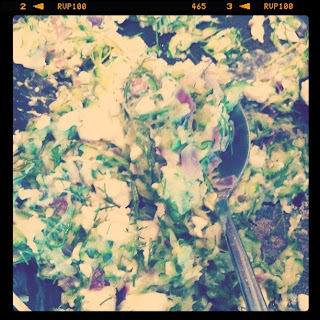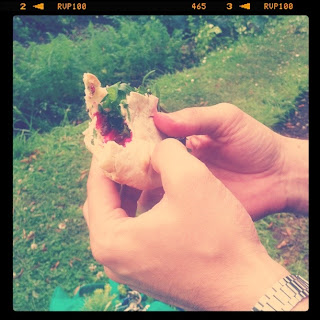We have grown.
Thursday 28 July 2011
Wednesday 27 July 2011
Hedgerow Ramblings // Thistles
Ted Hughes' words on the subject of thistles are far more eloquent than mine could ever hope to be.
I was rather pleased with this picture, however.
Thistles
Against the rubber tongues of cows and the hoeing hands of men
Thistles spike the summer air
And crackle open under a blue-black pressure.
Every one a revengeful burst
Of resurrection, a grasped fistful
Of splintered weapons and Icelandic frost thrust up
From the underground stain of a decayed Viking.
They are like pale hair and the gutturals of dialects.
Every one manages a plume of blood.
Then they grow grey like men.
Mown down, it is a feud. Their sons appear
Stiff with weapons, fighting back over the same ground.
Ted Hughes
Monday 25 July 2011
Hearth and Home // Eating Seasonally - Zuccini cakes with dill and feta
It was one of my resolutions this year to try and eat more locally sourced, seasonal produce. This mostly means vegetables as B and I barely eat meat nowadays and only really when we visit friends and family. The thinking behind these goals was both environmental and economical - buying produce which is out of season is costly and often requires long distance shipping. There were discussions about getting seasonal veg boxes delivered but then we lucked out with our allotment and we are now naturally eating what is in season and is locally grown!
Two of our favourite food writers - Hugh Furnly-Wurnly (as he is known in our household - to everyone else he is Hugh Fernley-Whittingstall) and Nigel Slater - have long championed fresh, seasonal, locally sourced produce and, as a result, their books are filled with delicious recipes categorised by season. Nigel Slater's The Kitchen Diaries has rapidly become my all-time favourite recipe book - if you can really call it that. There are recipes in it (by the fistful) but it is also a journal in the traditional sense, chronicling Mr Slater's day-to-day encounters with food. It is absolutely delightful to read and this recipe, from the July section was absolutely perfect for us to make use of the two things we have a glut of in the allotment currently: courgettes (zuccini) and dill! You can read my recent post about the benefits and other culinary uses of dill here, but this recipe is a great starting point.
You will need:
* 3 large courgettes (about 500 grams)
* 4 spring onions (or a medium onion)
* Olive oil
* 1 clove garlic
* 3 tbsp plain flour
* 1 large egg
* 100 g feta cheese
* A small bunch of dill (chopped)
* Salt and black pepper to season
Grate the courgette into a colander, sprinkle lightly with salt and allow to drain over the sink for around 30 minutes (you could do this into a tea towel and squeeze the water out if you are in a rush).
Chop the onions finely and warm them gently with a little oil in a pan. Add the garlic and courgette to the pan. When all is soft and turning a pale golden colour, add the flour and continue cooking for a couple of minutes, stirring occasionally. Beat the egg lightly and stir into the onion mixture, then crumble in the feta and chopped dill. Season to taste.
Finally, heat three tablespoons of oil in a shallow pan and drop heaped tablespoons of the mixture into the hot oil to cook. When golden on one side, turn over gently (they are pretty delicate so you will to be careful!). Lift the cakes out and drain on some kitchen paper. Serve as you wish...
We had ours with some home-made tzatziki and chunky potato wedges - also home-grown. Very satisfying!
Sunday 24 July 2011
Allotment Tales // An Impromptu Lunch
A warmed pitta, stuffed with some cold, roasted beetroot, a few slices of cheese, fresh tomatoes and a handful of just-picked rocket; enjoyed at the allotment, on a break from weeding.
Delicious.
Delicious.
Herbcraft // Dill
Dill is one of my favourite herbs - I absolutely love its flavour, largely, I think, because it brings back such strong memories of happy travelling experiences in Russia and Scandinavia, where it is native and used widely in culinary preparation.
Dill looks a lot like fennel, due to its bright green, feathery leaves and umbrellas of tiny flowers which turn to seed. However, it does not have the same aniseed scent, instead offering a sweeter, more subtle flavour that compliments fish well. The seeds are traditionally added to pickles in Russian and Scandinavian cuisine, and coupled with yoghurt and cucumber, make a fresh, cooling dip. More on the culinary uses of Dill to come later...
Medicinally, Dill has historically been used as a digestive aid, acting as a carminative, preventing gas and intestinal bloating. The seeds and leaves can be used in any number of recipes to calm the digestive system. Dill's essential oil can also be used to encourage milk production in breastfeeding women. However, Dill should be avoided during pregnancy.
Sunday 17 July 2011
Allotment Tales // Flowers as Food
In addition to providing us with vegetables, fruit and herbs, gardens and allotments are places of sanctuary and enjoyment, so it is wonderful to see so many colourful flowers in bloom through the summer as well.
What is truly delightful is the thought that, as well as being visually pleasing, many of these flowers have culinary uses too.
As I wrote earlier in the month, herbs such as borage and chamomile produce incredibly useful and pretty flowers. Chives, likewise have lovely purple pom-pom flowers, which can be eaten cooked or raw and have a strong flavour - something of a mixture between garlic and spring onions.
Courgette flowers can also be eaten, stuffed with cream cheese and herbs, or battered 'tempura' style. Nasturtium flowers are another edible treat; they taste distinctly like cress and really brighten up any plate of food.
This meal was concocted almost entirely from allotment produce. I simply fried some chopped yellow courgette and chopped chive flowers in a little olive oil; cooked the pasta and stirred through with the cooked veg, some wild rocket and nasturtium flowers (well washed, as they do attract tiny beasties) and added a sprinkling of feta cheese.
Delightful summer food!
Thursday 14 July 2011
Sunday 10 July 2011
Herbcraft // Drying Chamomile for Tea
Chamomile tea is enjoyed world-wide as a relaxing, soothing drink. It aides sleep, calms frayed nerves and soothes skin conditions gently enough to be suitable for even the most sensitive skin.
There are two variants of chamomile - Roman (or English) and German - which are largely used to treat similar conditions. Roman Chamomile is valued for its anxiety-relieving properties and is used to treat the emotional symptoms of PMS, while German Chamomile is most effective in treating inflammation and soothe irritating skin conditions such as eczema and psoriasis.
This year I grew my own Roman Chamomile from seed, in the hopes that I could make my own tea. The crop is now producing an abundance of these daisy-like flowers, which are harvested and used to make the tea.
Once you have picked your chamomile flowers (no stalks or leaves) they will need to be washed gently. First, place the flowers in a colander or sieve. Next, fill a bowl with cold water and four or five teaspoons of salt. Place the colander in the bowl, so the water begins to swirl through and gently clean the flowers. Leave them like this for around 10 minutes and then pick out any unwanted bits and beasties that float out from the flowers.
Once you have cleaned the flowers, take them out of the water and place on some kitchen paper or a towel. Pat dry gently and leave for around 20 minutes.
At this point you have a couple of options. You could choose to air-dry or sun-dry your chamomile flowers - there are instructions for this here. Alternatively, you can do as I did and oven-dry them.
You will need to allow your oven to heat to 200 degrees C and then turn off. Place your flowers on a tray lined with baking paper and place in the oven. It must be turned off or you will burn the flowers. Leave a slight crack in the door to allow air to circulate and allow the flowers around 4 hours in the oven to dry out completely. You may find that the oven goes cold and you need to repeat the process of removing the flowers, reheating to 200 degrees and turning off again before replacing.
Once you have dried your flowers, place in an air-tight container and they should keep for around 6 months. To make a cup of tea simply place a teaspoon of flowers per cup of boiling water and strain before serving.
Deliciously soothing.
Saturday 9 July 2011
Alice's Mug
For those of you who haven't already, you really should visit Alice's Bucket List
Alice is a beautiful, brave 15 year old girl who has terminal cancer. Her blog is her bucket list - a list of things she wants to achieve in the precious time she has left. In her words: 'You only have one life - live it!'
Today, Alice posted about one of her fantastic achievements since starting her blog - she has designed a stunning summery mug for Emma Bridgewater. You can buy it here, with a great-big £10 from every sale being contributed to Torbay Holiday Helpers Network, which supports families with terminally ill children.

Another of Alice's aims is to get EVERYONE to sign up to be a bone marrow donor. I'm going to take the first step towards doing so on Monday, when I go to give blood. (You need to be a blood donor, before you can be a bone marrow donor). While Alice and I have your attention, I would urge you to consider doing so also. When I look back at how much donor blood my dad needed when he was sick and consider that - had he been lucky enough - he would also have had a bone marrow transplant, it makes me so incredibly thankful for all those people who had taken the time and thought to donate. I'm ashamed to say I wasn't one of those people before then - I'm going to put that right now.
For more information about blood and bone marrow donation, if you are in the UK visit Give Blood and British Bone Marrow Registry or if you are in the USA visit The American Red Cross and National Marrow Donor Program.
Thank you.
Friday 8 July 2011
Allotment Tales // Rocket and Mizuna
Currently, we have more salad leaves than we know what to do with down at our allotment. We pick some every two or three days to have accompanying our meals and it just keeps growing in abundance!
This year sowed some rows of mixed leaves seeds and also some rocket on its own. What would grow from the mixed leaves was down to luck and the elements. This year we seem to have an abundance of mizuna.
Mizuna is an oriental salad leaf, sometimes also known as Japanese Greens or Japanese Mustard, because of its peppery taste. It is similar to rocket in that sense, but its leaves are more feathery. It grows vigorously and the stalks can get rather thick very quickly. As you can stir-fry them as well as eating them raw, this isn't really a problem. The smaller, tender leaves are great on their own or dressed simply with a bit of oil and balsamic or lemon juice. As it is a 'cut-and-come-again' variety, if you grow a patch, it should keep you going all through the summer.
Rocket is a bit trickier to grow - it isn't as vociferous in our patch and seems to be a real favourite for little beasties to chomp their way through. For this reason, I've started growing some more in a tray on the windowsill as well as outside. Most of what I pick from the allotment has tiny holes in it! A good wash and it's absolutely fine to eat, however, and I absolutely love its deep, peppery flavour with a few slices of parmesan cheese and a drizzle of olive oil and balsamic. It is rich in Vitamin C and potassium as well, and has long been considered an aphrodisiac!
What are you picking from your gardens and allotments this week?
Thursday 7 July 2011
Wednesday 6 July 2011
Herbcraft // Borage
Borage is a beautiful and, sadly, nowadays underused commodity in terms of medicinal and culinary herb-craft. Mostly it is grown commercially for its seed-oil and by savvy gardeners, who know that it attracts bees who pollenate their other plants.
Borage is also often known as 'starflower' thanks to its exquisite sapphire-blue star-shaped blossoms, which hang delicately for a day or two, before being scattered like confetti across the garden by even the lightest of breezes.
The nutritional and medicinal benefits of borage are wide-ranging. It is often used by medical herbalists as a metabolic regulator, hormonal regulator (making it useful in the treatment of symptoms of PMS or the menopause) and anti-inflammatory - particularly for respiratory inflammations such as bronchitis. Many gardeners also claim it improves the health and taste of vegetables and fruit next to which it grows.
You can eat raw borage leaves in salads; apparently it lends a flavour akin to cucumber. Also, the leaves can be cooked, similarly to spinach and used in soups and pasta dishes. In some Italian regions, borage is used to stuff ravioli - I love the sound of that! A cup of raw borage contains large quantities of vitamin A as well as several of the B vitamins, a significant amount of vitamin C, iron, magnesium, manganese, calcium, zinc and selenium - to name a few!
Borage flowers can also be eaten and provide a honey-sweet taste to deserts, salads and even drinks. A lovely trick to add interest and colour to summer drinks is to pop some of these flowers into your ice cube trays, before making ice. They add a beautiful summery something to a chilled glass of wine or elderflower cordial.

So if you have some of this delightful summer herb growing in your garden, try one of these traditional culinary uses before the flowers all scatter to the wind.
Sunday 3 July 2011
Allotment Tales // A Warm Summer Salad
I was delighted this week to spend an evening working at the allotment, my reward for which was this handful of fresh produce to cook up for my dinner.
This time of year sees courgettes, mange tout and peas, as well as handfuls of fresh lettuce, spinach and chard growing in abundance. I just loved the colourful combination of the mange tout, yellow courgettes and blue borage flowers in my bowl!
When I got them home I gave them a rinse, chopped the courgettes and simply tossed them in some garlic oil in the frying pan for 2 minutes. They were served up with a dollop of tzatziki.
A delightful, warm summer salad.
Subscribe to:
Posts (Atom)






























